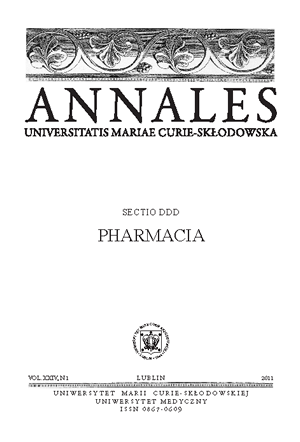The influence of oral administration of silicon on chromium concentrations in blood and chosen tissues of rats
Keywords:
chromium, silicon, ratsAbstract
Silicon is an essential nutrient. It has been found to take part in many life processes of animals related to tissue regeneration and maintaining healthy connective tissue and bones. It causes anticancerous, antiatherosclerotic and antidiabetic actions and beneficial effects on several human disorders, as for example osteoporosis, ageing of skin, hair and nails, atherosclerosis, wound healing and immune functions. Trivalent chromium compounds are recognized as essential for proper tissue functions in human. It actively participates in carbohydrate and lipid metabolism and this is the reason why it is popular as a supplement in diet for patients with diabetes and with parallel disturbance of lipid metabolism. Is has ability to increase muscle mass and reduce body fat in obese individuals. Chromium may also inhibit key enzymes in the synthesis of cholesterol, thus improving the lipid profile of individuals with dyslipidaemia. Results of our studies confirmed influence of orally administered silicon on concentrations of chromium in liver and blood of experimental animals, while no interactions between administered silicon and chromium concentrations in brain and kidneys were found.
Metabolism of silicon in human beings remains unknown and that is the reason for further studies concerning its utilization and its interactions with other elements and nutrients are needed.
References
1. Anderson R.A.: Chromium as an essential nutrient for humans, Regul. Toxicol. Pharmacol., 26, 35, 1997.
2. Bagchi D. et al.: Cytotoxity and oxidative mechanism of different forms of chromium, Toxicology, 180, 5, 2002.
3. Bissé E. et al.: Reference values for serum silicon in adults, Anal. Biochem., 337, 130, 2005.
4. Calomme M.R., Vanden Berghe D.A.: Supplementation of calves with stabilized orthosilicic acid. Effect on the Si, Ca, Mg, and P concentrations in serum and the collagen concentration in skin and cartilage, Biol. Trace Elem. Res., 56, 153, 1997.
5. Cefalu W.T., Hu F.B.: Role of chromium in human health and in diabetes, Diabetes Care, 27, 2741, 2004.
6. Costa M., Klein C.B.: Toxicity and carcinogenicity of chromium compounds in human, Crit. Rev. Toxicol., 36, 155, 2006.
7. Janczarski M., Janczarski D.: Rola kwasu ortokrzemowego w metaboliźmie organizmów żywych, Medycyna 2000, 9/10, 2, 1991.
8. Jugdaohsingh R. et al.: Dietary silicon intake and absorption, Am. J. Clin. Nutr., 75, 887, 2002.
9. Jugdaohsingh R. et al.: Dietary silicon intake is positively associated with bone mineral density in men and premenopausal women of the Framingham Offspring cohort, J. Bone Miner. Res., 19, 297, 2004.
10. Lanca S. et al.: Chromium-induced toxic hepatitis, Eur. J. Intern. Med., 13, 518, 2002.
11. Lansdown A.B., Williams A.: A prospective analysis of the role of silicon in wound care, J. Wound Care., 16, 404, 2007.
12. O'Connor C.I. et al.: Mineral balance in horses fed two supplemental silicon sources, J. Anim. Physiol. Anim. Nutr., 92, 173, 2008.
13. Popplewell J.F. et al.: Kinetics of uptake and elimination of silicic acid by a human subject: a novel application of 32Si and accelerator mass spectrometry, J. Inorg. Biochem., 69, 177, 1998.
14. Price Evans D.A. et al.: Chromium chloride administration causes a substantial reduction of coronary lipid deposits, aortic lipid deposits, and serum cholesterol concentration in rabbits, Biol. Trace Elem. Res., 130, 262, 2009.
15. Rico H. et al.: Effect of silicon supplement on osteopenia induced by ovariectomy in rats, Calcif. Tissue Int., 66, 53, 2000.
16. Sripanyakorn S. et al.: Dietary silicon and bone health, Nutr. Bull., 30, 222, 2005.
17. Volpe S.I. et al.: Effect of Chromium Supplementation and Exercise on Body Composition, Resting Metabolic Rate and Selected Biochemical Parameters in Moderately Obese Women Following an Exercise Program, J. Am. Coll. Nutr., 20, 293, 2001.
18. Wachter H. et al.: Diatomaceous earth lowers blood cholesterol concentrations, Eur. J. Med. Res., 3, 211, 1998.
Downloads
Published
Issue
Section
License
Copyright (c) 2011 Authors

This work is licensed under a Creative Commons Attribution-NonCommercial-NoDerivatives 3.0 Unported License.


